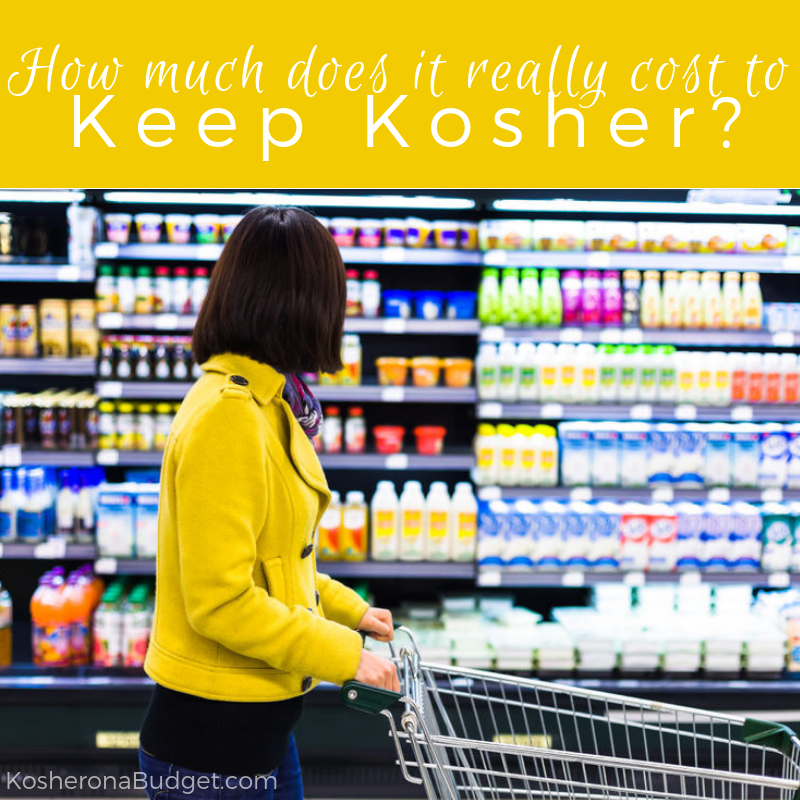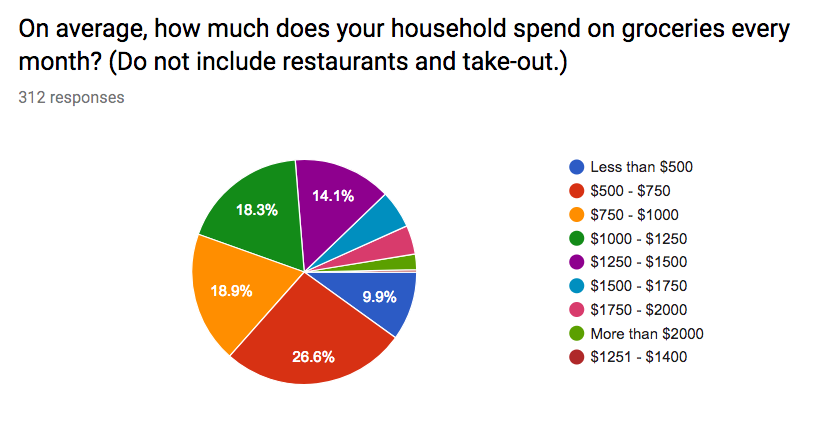
A huge thank you to the more than 300 of you whom responded to my survey about your average grocery spending.
I kept the survey open for 10 weeks, so we could get as many responses as possible. Let’s jump right in and look at the numbers you shared.
How much do KOAB readers spend on groceries?

A plurality of you — 28.6% — said you spend between $500 and $750 per month on groceries.
Another 37% said that you spend between $750 and $1,250, while 14.1% say you spend between $1,250 and $1,500.
Just under 1 in 10 say your spending comes in at under $500 (way to go!), while another 1 in 10 say you are spending over $1,500 per month.
What do you make of these numbers? Do they ring true to you?
Here are my impressions, in no particular order, after studying your answers in depth:
#1. Mea culpa: I really goofed in terms survey design.
The next time I do this survey, I’m going to have to figure out how to tie your answers to the number of people living in your home — and the ages of your children.
For example, 14.6% of you said that you have no children living at home. And another 26% of you said that you have two or fewer children.
Also interestingly, the overwhelming majority of you — upwards of 80% — said your children are aged 9 or under.
I think that these two pieces of data — number of children and the age of those children — can really skew answers one way or the other.
I have two teenagers, and they eat a lot!!!!
I sure have seen in my own life just how much having children — and especially teens! — increases your food costs. For example, I spend twice as much on groceries today as I did 8 years ago. My kids are now 15 (boy), 13 (boy) and 9 (girl), instead of 7, 5 and 1. In other words: They eat a whole lot more.
#2. I needed to be more clear about what I consider “groceries”.
For me, groceries means not only food we eat at home, but also cleaning supplies, paper goods (like toilet paper and disposable plates), and personal care products (like shampoo and toothpaste).
When I had babies in diapers, I included those as well. And had we fed them formula, that also would have appeared in our grocery budget.
And what if you have a pet? Does their food count as groceries? Some of you said yes.
We have two dogs (labs) so that has to be factored in. It’s probably $50-$75 a month just for them.
Many of you, on the other hand, commented to me privately that since you weren’t sure how to answer this survey, you answered about your food-only costs.
I wasn’t sure if I should be calculating things like diapers (for two), paper towel, toilet paper and dish soap. If I add all those things in, we’re easily spending $150 more per month.
There is no right or wrong answer as to how to categorize your spending, but for a survey like this, it would have been much more helpful if I had thought to clarify this in advance!
I suspect that as a result of my mess-up, we’re not really comparing apples to apples when it comes to cost averages.
#3. Food sensitives and dietary restrictions also impact your spending totals.
This probably seems pretty obvious, but I was really impressed by your private responses about just how much these factors have increased your spending.
We have many food allergies or restrictions: no dairy for one, two who do not eat regular flour, no corn, avoid food coloring, artificial flavors, artificial sweeteners, try to stay with some organic foods. It’s a lot!
Whether you keep chalav yisrael, have a child with food allergies, or are gluten-free, there is no doubt that sensitivities, allergies and restrictions can increase — sometimes significantly — the cost of your weekly grocery bill.
We have a child who cannot drink cow’s milk and is instead on cashew or almond milk; this alone raises our food bill by $30-$40 a month.
#4. Geographic location also plays a big role in your grocery bill.
I have often heard the term food desert, but never thought about how that could affect kosher-keepers.
We live out of town so meat and chicken is more pricy and I don’t have access to cheaper stores; I’d have to invest in a good freezer and have my mom send me food from Brooklyn.
Typically the term “food desert” refers to low income areas. Without usurping that term, I think we can apply the concept to the survey results. I definitely saw in your responses that living in areas without many — or any — grocery shopping options can really increase your monthly spending.
We live in Manhattan. That, plus a lack of car leads me to spend waaay more on groceries than I should be.
#5. Shabbat & Yom Tov are expensive!
I know, duh! But we can’t underestimate the financial impact of cooking for Shabbat & yomtov.
As I often tell my non-Jewish friends, it’s like making Thanksgiving dinner twice a week, every week of the year! And then there’s Tishrei and Nissan!
Compounding the expense is the added costs of hosting guests. Even if you invite just one other family, that’s can double your Shabbat “bill”.
If I am consistently making Shabbat or holiday meals, that number likely goes up to $2, 000 a month or more.
A number of you commented to me privately that this is your #1 challenge when it comes to budgeting for groceries.
We host Friday night meals every week and holiday meals every holiday; we serve about 15-17 people for evening Shabbat meals and 3-4 for lunch.
#6. No matter how much you’re spending, we all would like to spend less.
Whether you’re spending $500 or $2,500, it seems that nearly everyone wishes they were spending less.
And that makes sense, since grocery spending is one of those categories in our budget where our behavior can really affect our costs.
For example, unless you refinance, there’s no lowering your mortgage bill. It’s a fixed expense.
I knew my food spending was getting out of control when it surpassed mortgage. And I live in LA! I’m not sure what we’re doing wrong. Maybe with five kids (and two of them being teenagers), it just is what it is. But it’s killing us!
Grocery spending, however, is variable. Sure we can spend less by eating less. But that sounds kind of unpleasant, doesn’t it?
Fortunately, it’s possible to lower your costs without starving your family — or feeding them a steady diet of Ramen and peanut butter.
In my flagship online course, The Kosher Grocery Academy, I teach students how to cut their grocery spending by 30% or more each month — without compromising quality, quantity or kashrut. Yes, it is possible! LEARN MORE HERE.
What are you thoughts about the results of the grocery survey? Do they seem accurate to you? Too low? Too high?
Are there other major factors that impact your spending?
Let’s talk in the comments section!











Leave a Comment